Maths Solution Class 10 Chapter 9: Some Applications of TrigonometryExercise 9.11. A circus artist is climbing a 20 m long rope, which is tightly stretched and tied from the top of a vertical pole to the ground. Find the height of the pole, if the angle made by the rope with the ground level is 30° (see Fig. 9.11). 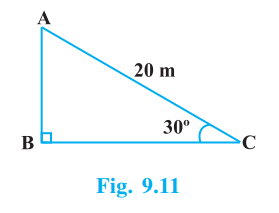
Solution It can be observed that ABC is a right angled triangle with AC as the hypotenuse. Therefore, sin C = AB/AC sin 30° = AB/20 1/2 = AB/20 AB = 20/2 = 10 m Hence, the height of the vertical pole is 10 m. 2. A tree breaks due to storm and the broken part bends so that the top of the tree touches the ground making an angle 30° with it. The distance between the foot of the tree to the point where the top touches the ground is 8 m. Find the height of the tree. Solution 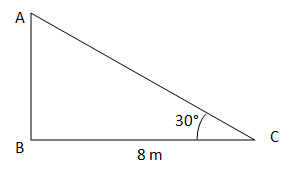
Let the remaining vertical part of tree be AB and the fallen part be AC. It can be noted that ABC forms a right angled triangle with AC as its hypotenuse. Thus, cos C = BC/AC cos 30° = 8/AC √3/2 = 8/AC AC = 16/√3 m tan C = AB/BC 1/√3 = AB/8 AB = 8/√3 m Height of the tree = AB + AC = 8/√3 m + 16/√3 m = 24/√3 m Rationalise, 24/√3 × √3/√3 = 8√3 m Hence, the height of the tree is 8√3 m. 3. A contractor plans to install two slides for the children to play in a park. For the children below the age of 5 years, she prefers to have a slide whose top is at a height of 1.5 m, and is inclined at an angle of 30° to the ground, whereas for elder children, she wants to have a steep slide at a height of 3m, and inclined at an angle of 60° to the ground. What should be the length of the slide in each case? Solution 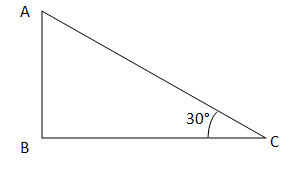 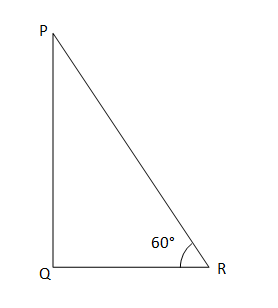
Let the slide for children younger than 5 years be represented by ABC and the slide for elder children be represented by PQR. AB = 1.5 m and PQ = 3 m. In ABC, we have sin C = AB/AC sin 30° = 1.5/AC 1/2 = 1.5/AC AC = 3 m In PQR, we have sin R = PQ/PR sin 60° = 3/PR √3/2 = 3/PR PR = 6/√3 m Rationalise, 6/√3 × √3/√3 = 2√3 m Hence, the length of slide for younger children = 3 m, and length of slide for elder children = 2√3 m 4. The angle of elevation of the top of a tower from a point on the ground, which is 30 m away from the foot of the tower, is 30°. Find the height of the tower. Solution 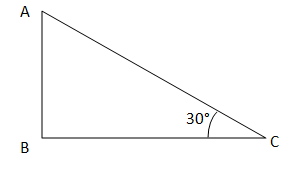
Let AB be the tower and C be the point 30 m away from the foot B. tan C = AB/BC tan 30° = AB/30 1/√3 = AB/30 AB = 30/√3 m Rationalize, 30/√3 × √3/√3 = 10√3 m Hence, the height of the tower is 10√3 m. 5. A kite is flying at a height of 60 m above the ground. The string attached to the kite is temporarily tied to a point on the ground. The inclination of the string with the ground is 60°. Find the length of the string, assuming that there is no slack in the string. Solution 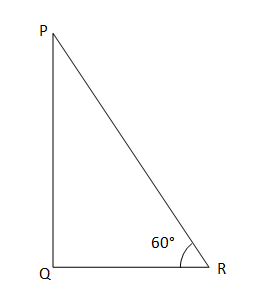
Let PQ be the height of the kite from ground and PR be the string attached to the kite. sin R = PQ/PR sin 60° = 60/PR √3/2 = 60/PR PR = 120/√3 m Rationalise, 120/√3 × √3/√3 = 40√3 m Hence, the length of the string assuming it has no slack is 40√3 m. 6. A 1.5 m tall boy is standing at some distance from a 30 m tall building. The angle of elevation from his eyes to the top of the building increases from 30° to 60° as he walks towards the building. Find the distance he walked towards the building. Solution 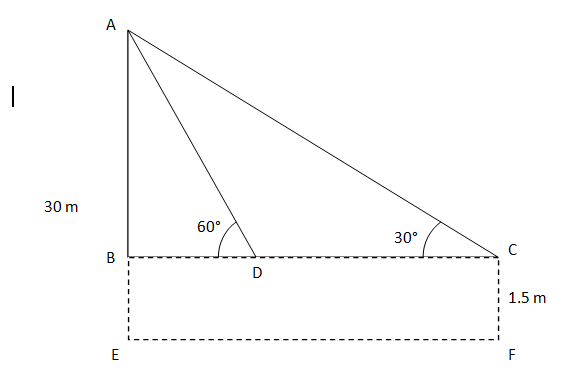
Let the above figure represent the given situation. AE = Height of Building = 30 m CF = Height of the boy = 1.5 m BC = Distance between boy and the building DC = Displacement of the boy from his original position C In ABC, we have tan C = AB/BC tan 30° = (AE - CF)/BC 1/√3 = (30 - 1.5)/BC BC = 28.5√3 m In ABD, we have tan D = AB/BD tan 60° = 28.5/BD √3 = 28.5/BD BD = 28.5/√3 m Rationalize, 28.5/√3 × √3/√3 = 9.5√3 m CD = BC - BD = 28.5√3 m - 9.5√3 m = 19√3 m Hence, the boy walked 19√3 m towards the building. 7. From a point on the ground, the angles of elevation of the bottom and the top of a transmission tower fixed at the top of a 20 m high building are 45° and 60° respectively. Find the height of the tower. Solution 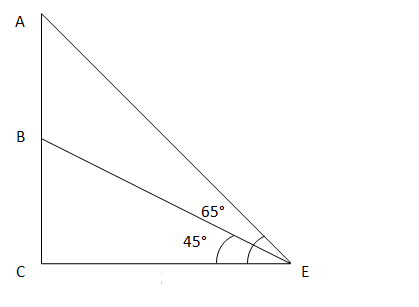
Let AB be the transmission tower on top of building BC. The required point on the ground is E. In BCE, we have tan CEB = BC/CE tan 45° = 20/CE 1 = 20/CE CE = 20 m In ACE, we have tan CEA = AC/CE tan 60° = AC/20 √3 = AC/20 AC = 20√3 m Height of transmission tower = AB = AC - BC = 20√3 - 20 = 20(√3 - 1) m Hence, height of the transmission tower = 20(√3 - 1) m 8. A statue, 1.6 m tall, stands on the top of a pedestal. From a point on the ground, the angle of elevation of the top of the statue is 60° and from the same point the angle of elevation of the top of the pedestal is 45°. Find the height of the pedestal. 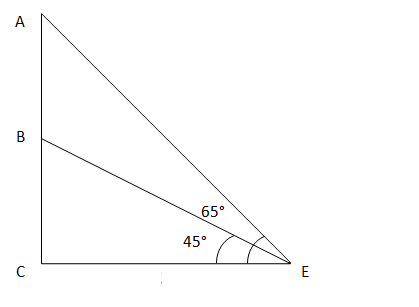
Solution Let AB be the statue on the pedestal BC and let E be the point on the ground. In ACE, we have tan CEA = AC/CE tan 60° = (AB + BC)/CE √3 = (1.6 + BC)/CE (1.6 + BC)/√3 = CE In BCE, we have tan CEB = BC/CE tan 45° = BC/CE 1 = BC/CE CE = BC Therefore, (1.6 + BC)/√3 = BC 1.6 + BC = BC√3 1.6 = BC(√3 - 1) BC = 1.6/(√3 - 1) Rationlaize, BC = 1.6/(√3 - 1) × (√3 + 1)/(√3 + 1) BC = 1.6(√3 + 1)/2 BC = 0.8(√3 + 1) m Hence, height of the pedestal is 0.8(√3 + 1) m. 9. The angle of elevation of the top of a building from the foot of the tower is 30° and the angle of elevation of the top of the tower from the foot of the building is 60°. If the tower is 50 m high, find the height of the building. Solution 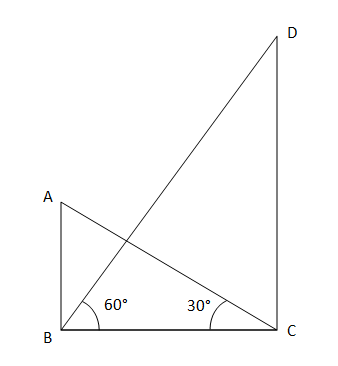
Let AB be the building and DC be the tower. In BCD, we have tan B = DC/BC tan 60° = 50/BC √3 = 50/BC BC = 50/√3 Rationalise, BC = 50/√3 × √3/√3 = 50√3/3 m In ABC, we have tan C = AB/BC 1/√3 = AB/(50√3/3) AB = 50/3 m Hence, height of the building is 50/3 m. 10. Two poles of equal heights are standing opposite each other on either side of the road, which is 80 m wide. From a point between them on the road, the angles of elevation of the top of the poles are 60° and 30°, respectively. Find the height of the poles and the distances of the point from the poles. Solution 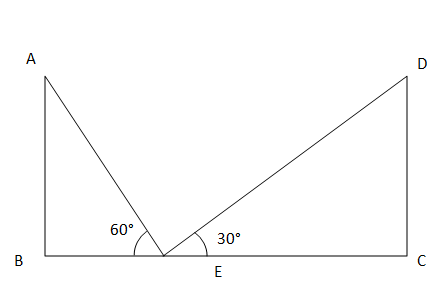
Let AB and DC be the poles on road BC and let the required point on the road be E. In DCE, we have tan E = CD/EC tan 30° = CD/EC 1/√3 = CD/EC CD = EC/√3 In ABE, we have tan E = AB/BE tan 60° = AB/BE √3 = AB/BE AB = BE√3 We know that AB = CD (Given). Therefore, EC/√3 = BE√3 We also know that EC = 80 - BE. Therefore, (80 - BE)/√3 = BE√3 80 - BE = 3BE 80 = 4BE BE = 20 m Therefore, EC = 80 - 20 = 60 m AB = CD = 20√3 m Hence, the height of the poles is 20√3 m and the distance of the point from the poles is 20 m and 60 m respectively. 11. A TV tower stands vertically on a bank of a canal. From a point on the other bank directly opposite the tower, the angle of elevation of the top of the tower is 60°. From another point 20 m away from this point on the line joing this point to the foot of the tower, the angle of elevation of the top of the tower is 30° (see Fig. 9.12). Find the height of the tower and the width of the canal. 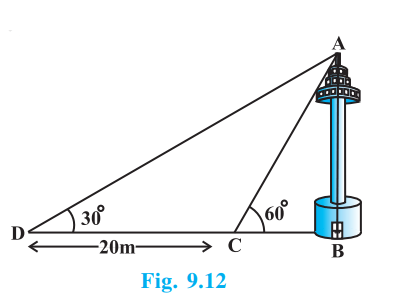
Solution In ABD, we have tan D = AB/BD tan 30° = AB/BD 1/√3 = AB/(20 + BC) AB = (20+BC)/√3 In ABC, we have tan C = AB/BC tan 60° = AB/BC √3 = AB/BC AB = √3 BC Therefore, √3 BC = (20 + BC)/√3 3BC = 20 + BC 2 BC = 20 BC = 10 m AB = 10√3 m Hence, height of the tower is 10√3 m and width of the canal is 10 m. 12. From the top of a 7 m high building, the angle of elevation of the top of a cable tower is 60° and the angle of depression of its foot is 45°. Determine the height of the tower. Solution 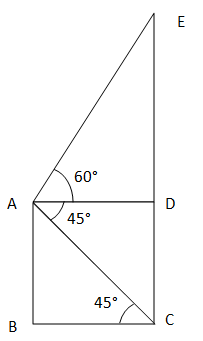
Let AB be the 7 m high building and let the cable tower be EC. AD is an imaginary line drawn parallel to the ground BC. AB = CD = 7 m In ACD, we have tan A = CD/AD tan 45° = 7/AD 1 = 7/AD AD = 7 m In ADE, we have tan A = DE/AD tan 60° = DE/7 √3 = DE/7 DE = 7√3 m EC = DE + CD = 7√3 + 7 = 7(√3 + 1) m Hence, the height of the cable tower is 7(√3 + 1) m. 13. As observed from the top of a 75 m high lighthouse from the sea-level, the angles of depression of two ships are 30° and 45°. If one ship is exactly behind the other on the same side of the lighthouse, find the distance between the two ships. Solution 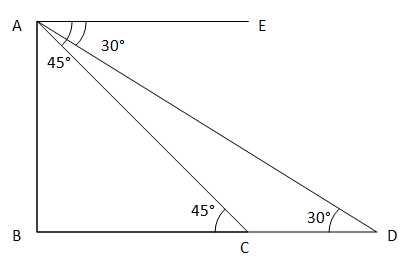
Let AB be the lighthouse and C and D be the positions of the ships in the sea respectively. Draw an imaginary line AE which is parallel to the sea level BD. In ABC, we have tan C = AB/BC tan 45° = AB/BC 1= 75/BC BC = 75 m In ABD, we have tan D = AB/BD tan 30° = AB/BD 1/√3 = 75/BD BD = 75√3 m CD = BD - BC = 75√3 - 75 = 75(√3 - 1) m Hence, distance between the two ships in the sea = 75(√3 - 1) m 14. A 1.2 m tall girl spots a balloon moving with the wind in a horizontal line at a height of 88.2 m from the ground. The angle of elevation of the balloon from the eyes of the girl at any instant is 60°. After some time, the angle of elevation reduces to 30° (see Fig. 9.13). Find the distance travelled by the balloon during the interval. 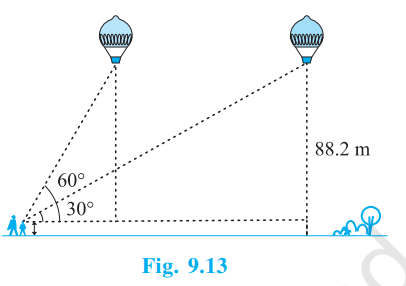
Solution 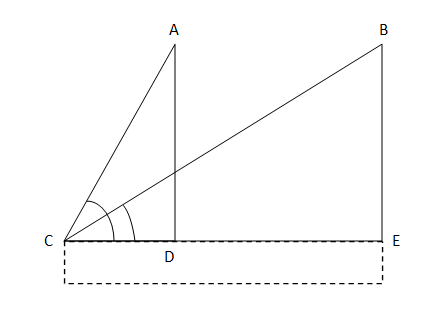
Let A and B be the initial and final positions of the balloon. Let C be the head of the girl. AD and BE are imaginary lines drawn perpendicular to the ground from the positions of the balloon. AD = BE = 88.2 - 1.2 = 87 m (Unchanged elevation in the balloon) In ACD, we have tan C = AD/CD tan 60° = AD/CD √3 = 87/CD CD = 87/√3 Rationalize, CD = 87/√3 × √3/√3 = 29√3 m In BCE, we have tan C = BE/CE tan 30°= 87/CE 1/√3 = 87/CE CE = 87√3 m DE = CE - CD = 87√3 - 29√3 = 58√3 m Hence, the distance travelled by the balloon is 58√3 m. 15. A straight highway leads to the foot of a tower. A man standing at the top of the tower observes a car at an angle of depression of 30°, which is approaching the foot of the tower with a uniform speed. Six seconds later, the angle of depression of the car is found to be 60°. Find the time taken by the car to reach the foot of the tower from this point. Solution 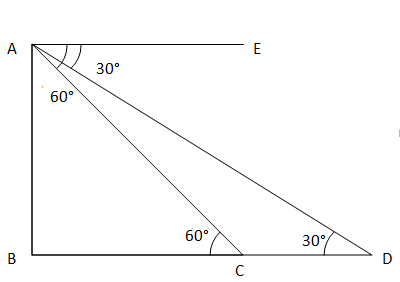
Let AB be the tower. Let D and C be the car's initial and final positions respectively. Draw an imaginary line AE which is parallel to the ground. In ABC, we have tan C = AB/BC tan 60° = AB/BC √3 = AB/BC BC = AB/√3 AB = √3 BC In ABD, we have tan D = AB/AD tan 30° = AB/BD 1/√3 = AB/BD AB = BD/√3 Rationalize, AB = BD/√3 × √3/√3 = BD√3/3 Therefore, BD√3/3 = √3 BC BD = 3BC 3BC = BC + CD 2BC = CD BC = CD/2 Time taken to travel distance CD = 6 s Hence, time taken to travel distance BC = CD/2 = 6/2 = 3 s 16. The angles of elevation of the top of a tower from two points at a distance of 4 m and 9 m from the base of the tower and in the same straight line with it are complementary. Prove that the height of the tower is 6 m. Solution 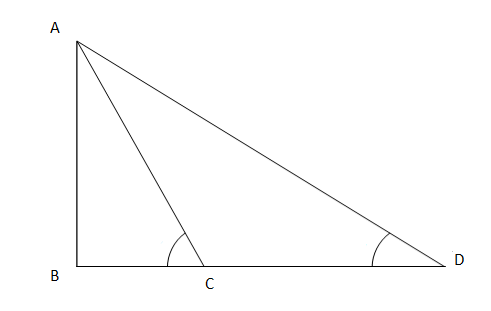
Let AB be the tower and C and D be the two required points on the ground. Let angle ACB be x, then angle ABD = 90 - x In ABC, we have tan x = AB/BC tan x = AB/4 AB = 4 tan x In ABD, we have tan (90°-x) = AB/BD cot x = AB/9 AB = 9 cot x Multiply both the obtained equations: AB2 = 36 tan x cot x AB2 = 36 tan x (1/tan x) AB2 = 36 AB = 6 m as height cannot be negative. Hence, the height of the tower has been proven to be 6 m.
Next TopicClass 10 Maths Chapter 10
|
 For Videos Join Our Youtube Channel: Join Now
For Videos Join Our Youtube Channel: Join Now
Feedback
- Send your Feedback to [email protected]
Help Others, Please Share










